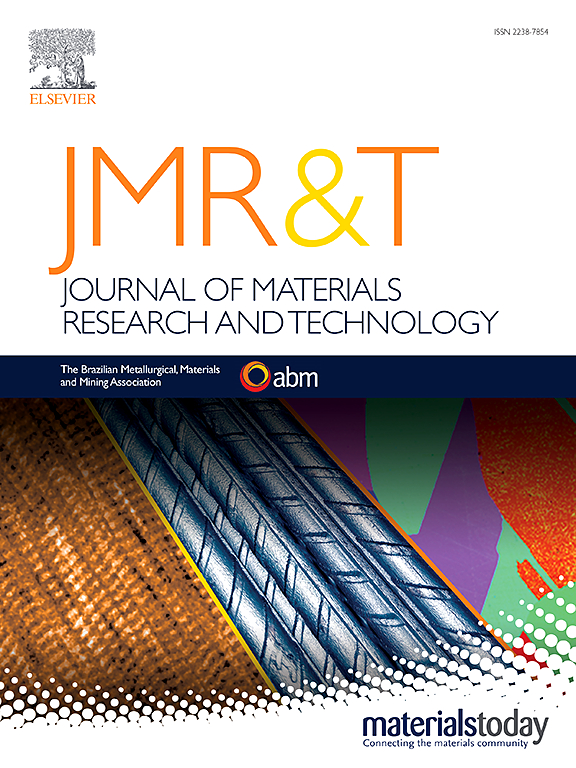PBAT biocomposites reinforced with açaí seed residues: Exploring sustainable material development
IF 6.6
2区 材料科学
Q1 MATERIALS SCIENCE, MULTIDISCIPLINARY
Journal of Materials Research and Technology-Jmr&t
Pub Date : 2025-06-04
DOI:10.1016/j.jmrt.2025.06.008
引用次数: 0
Abstract
Developing sustainable materials is essential for advancing eco-friendly technologies and promoting circular economy practices. This study investigates the reinforcement of poly(butylene adipate-co-terephthalate) (PBAT) with açaí seed residues (ASR), an abundant agro-industrial byproduct from Brazil. The residues were characterized using FTIR, XRD, TGA, and SEM, while the biocomposites underwent mechanical, morphological, and thermal evaluations. Composites were prepared by mixing PBAT with 20 wt% and 40 wt% of ASR in an internal mixer equipped with ROLLER-type rotors, followed by injection molding. Compared to neat PBAT, the incorporation of ASR resulted in a 37 % and 53 % reduction in tensile strength (from 19.71 MPa to 12.37 MPa and 9.19 MPa, respectively). The elastic modulus increased by 8.8 % and 20.1 %. Yield strength remained relatively stable, with values of 9.75 MPa (PBAT), 10.79 MPa (20 % ASR), and 9.29 MPa (40 % ASR). The total strain at break decreased from 239 % (neat PBAT) to 150 % (20 % ASR) and 121 % (40 % ASR). Flexural strength increased by 39 %, from 7.5 MPa to 10.4 MPa at 40 % ASR, while flexural modulus rose by 62 %, from 191 MPa to 310 MPa. Thermal analysis revealed a nucleating effect of the filler, elevating the crystallization temperature from 65.55 °C to 79.90 °C. The thermal resistance of all biocomposites showed a similar weight loss curve profile as a function of temperature, with a slight reduction in the initial degradation temperature (Tonset) compared to neat PBAT. Water absorption rose from 0.50 % in neat PBAT to 3.75 % at 40 % filler, attributed to the hydrophilic nature of the residues. These findings highlight the potential of açaí seed residues as reinforcement in the development of polymer biocomposites for sustainable applications.
以açaí种子残留物增强PBAT生物复合材料:探索可持续材料的发展
开发可持续材料对于推进环保技术和促进循环经济实践至关重要。本研究研究了巴西丰富的农工业副产物açaí种子残留物(ASR)对聚己二酸丁二酯(PBAT)的增强作用。利用FTIR、XRD、TGA和SEM对残基进行了表征,并对生物复合材料进行了力学、形态和热评价。将PBAT与20 wt%和40 wt%的ASR混合,在配备滚柱式转子的内混配器中制备复合材料,然后注射成型。与纯PBAT相比,ASR的掺入导致拉伸强度降低37%和53%(分别从19.71 MPa降至12.37 MPa和9.19 MPa)。弹性模量分别提高了8.8%和20.1%。屈服强度保持相对稳定,分别为9.75 MPa (PBAT)、10.79 MPa (20% ASR)和9.29 MPa (40% ASR)。断裂总应变从239%(纯PBAT)下降到150% (20% ASR)和121% (40% ASR)。当ASR为40%时,抗弯强度增加了39%,从7.5 MPa增加到10.4 MPa,而抗弯模量增加了62%,从191 MPa增加到310 MPa。热分析表明,填料有成核作用,结晶温度从65.55℃升高到79.90℃。与纯PBAT相比,所有生物复合材料的热阻表现出相似的失重曲线,其初始降解温度(Tonset)略有降低。由于PBAT的亲水性,其吸水性由纯PBAT时的0.50%提高到40%填料时的3.75%。这些发现突出了açaí种子残留物作为可持续应用的聚合物生物复合材料开发中的增强剂的潜力。
本文章由计算机程序翻译,如有差异,请以英文原文为准。
求助全文
约1分钟内获得全文
求助全文
来源期刊

Journal of Materials Research and Technology-Jmr&t
Materials Science-Metals and Alloys
CiteScore
8.80
自引率
9.40%
发文量
1877
审稿时长
35 days
期刊介绍:
The Journal of Materials Research and Technology is a publication of ABM - Brazilian Metallurgical, Materials and Mining Association - and publishes four issues per year also with a free version online (www.jmrt.com.br). The journal provides an international medium for the publication of theoretical and experimental studies related to Metallurgy, Materials and Minerals research and technology. Appropriate submissions to the Journal of Materials Research and Technology should include scientific and/or engineering factors which affect processes and products in the Metallurgy, Materials and Mining areas.
 求助内容:
求助内容: 应助结果提醒方式:
应助结果提醒方式:


